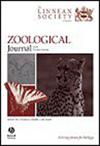生态和系统发育对野生灵长类动物四肢关节运动学的影响
IF 3
2区 生物学
Q1 ZOOLOGY
引用次数: 0
摘要
树栖运动岌岌可危,对稳定性提出了多重挑战。研究表明,人工饲养的灵长类动物会通过弯曲四肢关节和采取顺从步态来应对较窄和较陡的支撑物。我们测试了野生灵长类动物在自然栖息地的各种支撑物上自由活动时是否也会采取同样的运动反应。我们用改装过的 GoPro 摄像机记录了五种板翅类灵长类动物、五种猫翅类灵长类动物和四种链翅类灵长类动物,并使用远程测量来量化基质特征。视频图像被导入到 ImageJ 中,以测量四足动物在各种树栖支撑物上运动时四肢关节的角度运动学特性。我们用统计学方法检验了关节姿态与基质特征之间的关联,然后利用变异分区和冗余分析分离了系统发育和基质对四肢关节运动学的影响。我们的研究结果部分证实了之前的运动学研究,并表明支撑方向的变化比直径或顺应性更能影响四足动物的步态运动学。系统发育相关性比基底特性更能解释数据的变化。这表明灵长类动物要么会选择相对 "安全 "的基底进行运动,要么它们具有独立于肢体关节运动学本身的运动适应性,以克服岌岌可危的树栖环境所带来的挑战。本文章由计算机程序翻译,如有差异,请以英文原文为准。
Ecological and phylogenetic influences on limb joint kinematics in wild primates
Arboreal locomotion is precarious and places multiple challenges upon stability. Studies have shown that captive primates respond to narrower and steeper supports by flexing limb joints and adopting a compliant gait. We tested whether these same kinematic responses are adopted by wild primates freely ranging over a variety of supports in their natural habitats. We recorded five species of platyrrhines, five species of catarrhines, and four species of strepsirrhines with modified GoPro cameras and used remote measurement to quantify substrate characteristics. Video images were imported into ImageJ to measure the angular kinematics of limb joints during quadrupedal locomotion on a variety of arboreal supports. We statistically tested for associations between joint posture and substrate characteristics, and then disentangled the influence of phylogeny and substrate on limb joint kinematics using variation partitioning and redundancy analysis. Our results partially confirm previous kinematic studies and suggest variation in support orientation, more than diameter or compliance, influences quadrupedal gait kinematics. Phylogenetic relatedness explained more variation in the data than substrate properties. This suggests primates either prospectively choose relatively ‘safe’ substrates for locomotion, or that they possess locomotor adaptations independent of limb joint kinematics per se to overcome the challenges of the precarious arboreal environment.
求助全文
通过发布文献求助,成功后即可免费获取论文全文。
去求助
来源期刊
CiteScore
6.50
自引率
10.70%
发文量
116
审稿时长
6-12 weeks
期刊介绍:
The Zoological Journal of the Linnean Society publishes papers on systematic and evolutionary zoology and comparative, functional and other studies where relevant to these areas. Studies of extinct as well as living animals are included. Reviews are also published; these may be invited by the Editorial Board, but uninvited reviews may also be considered. The Zoological Journal also has a wide circulation amongst zoologists and although narrowly specialized papers are not excluded, potential authors should bear that readership in mind.

 求助内容:
求助内容: 应助结果提醒方式:
应助结果提醒方式:


